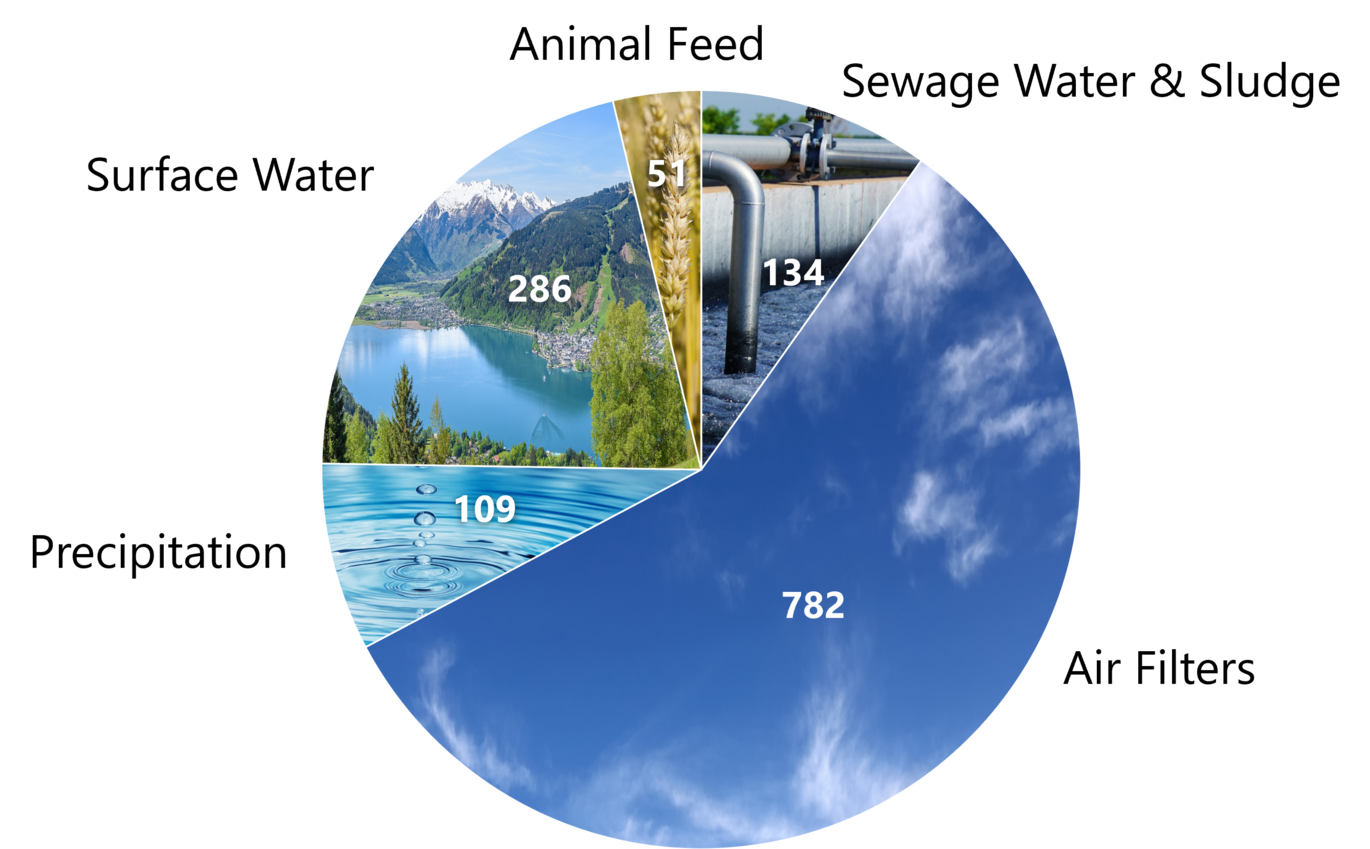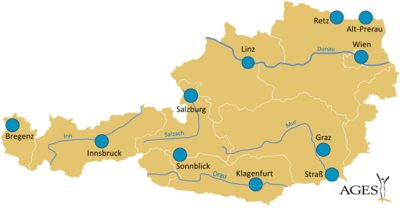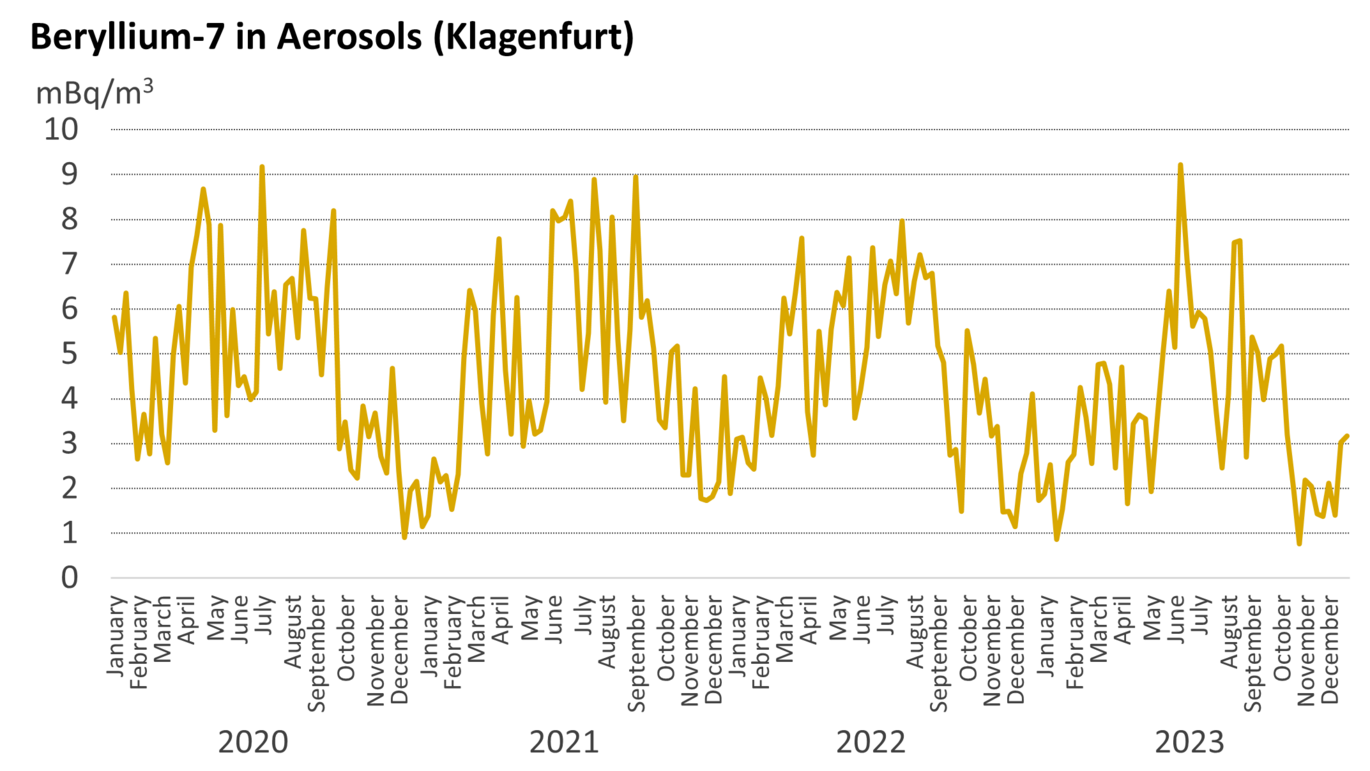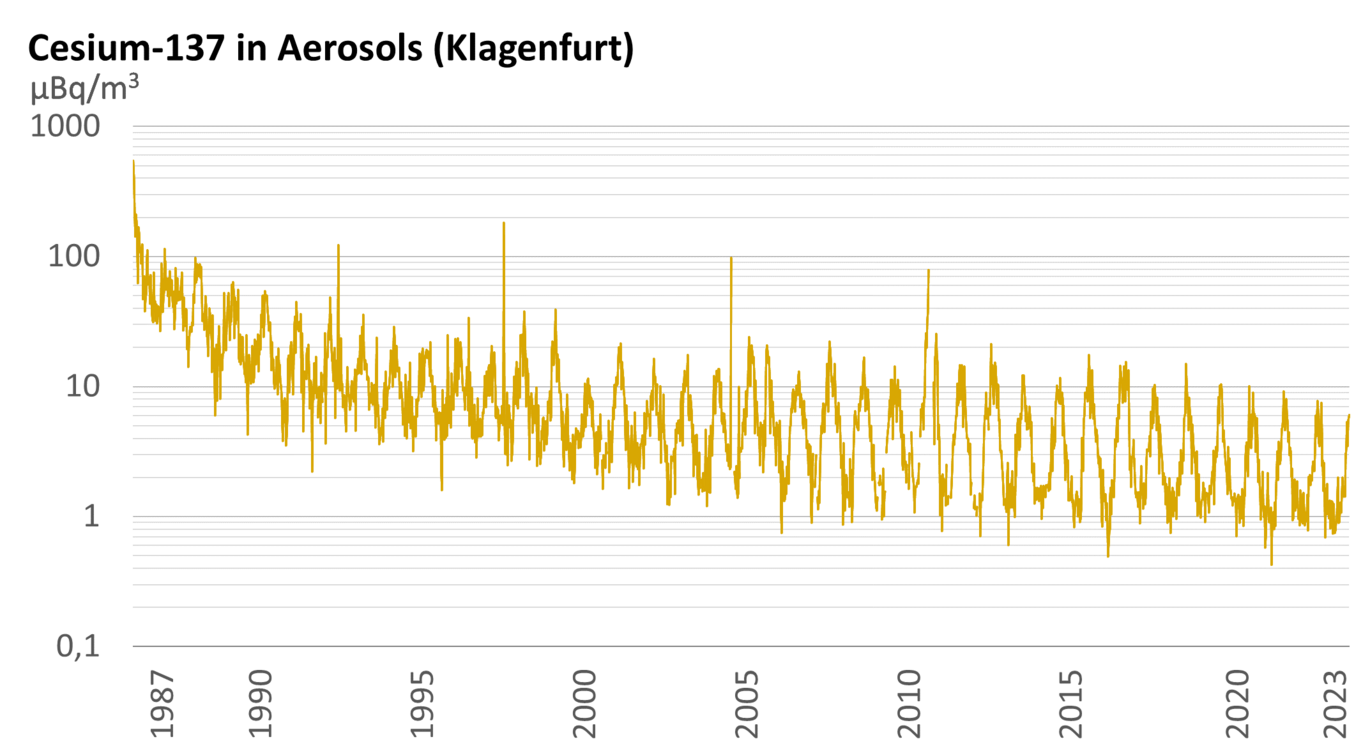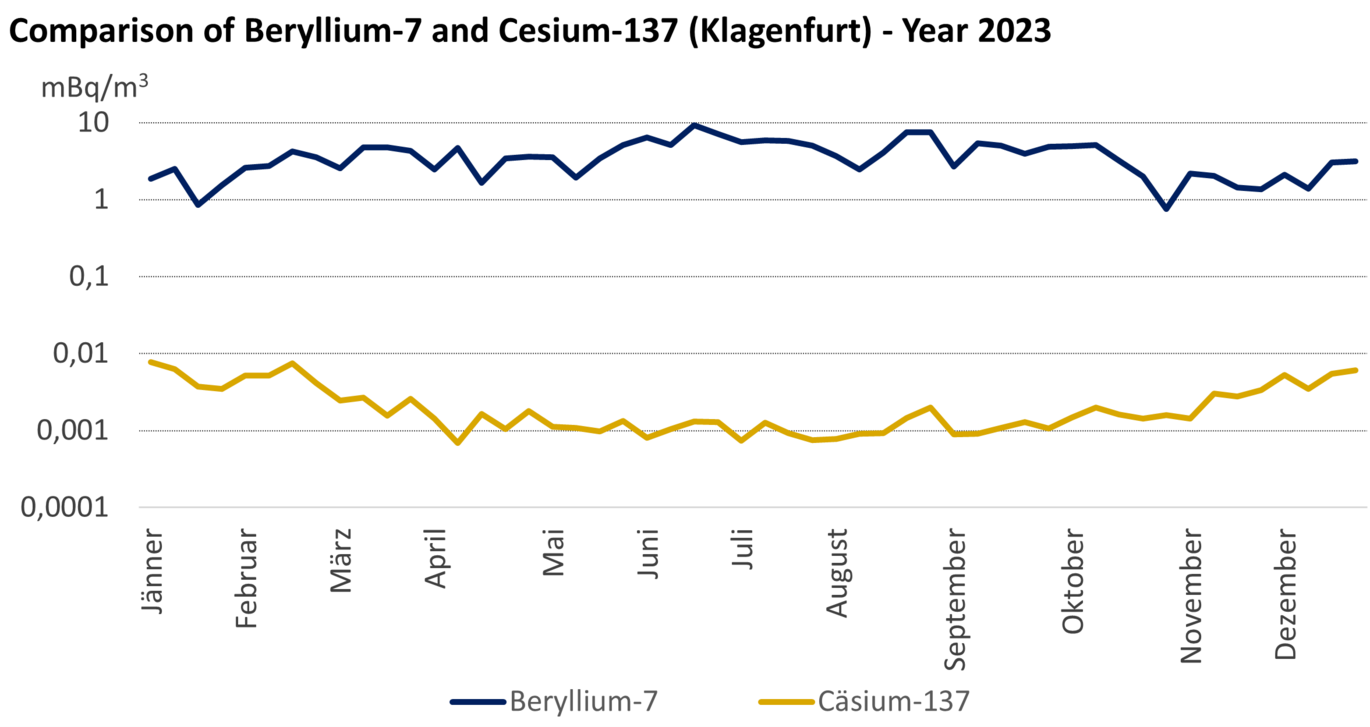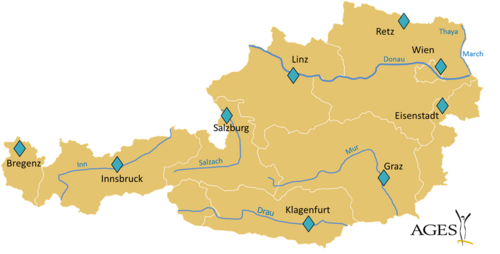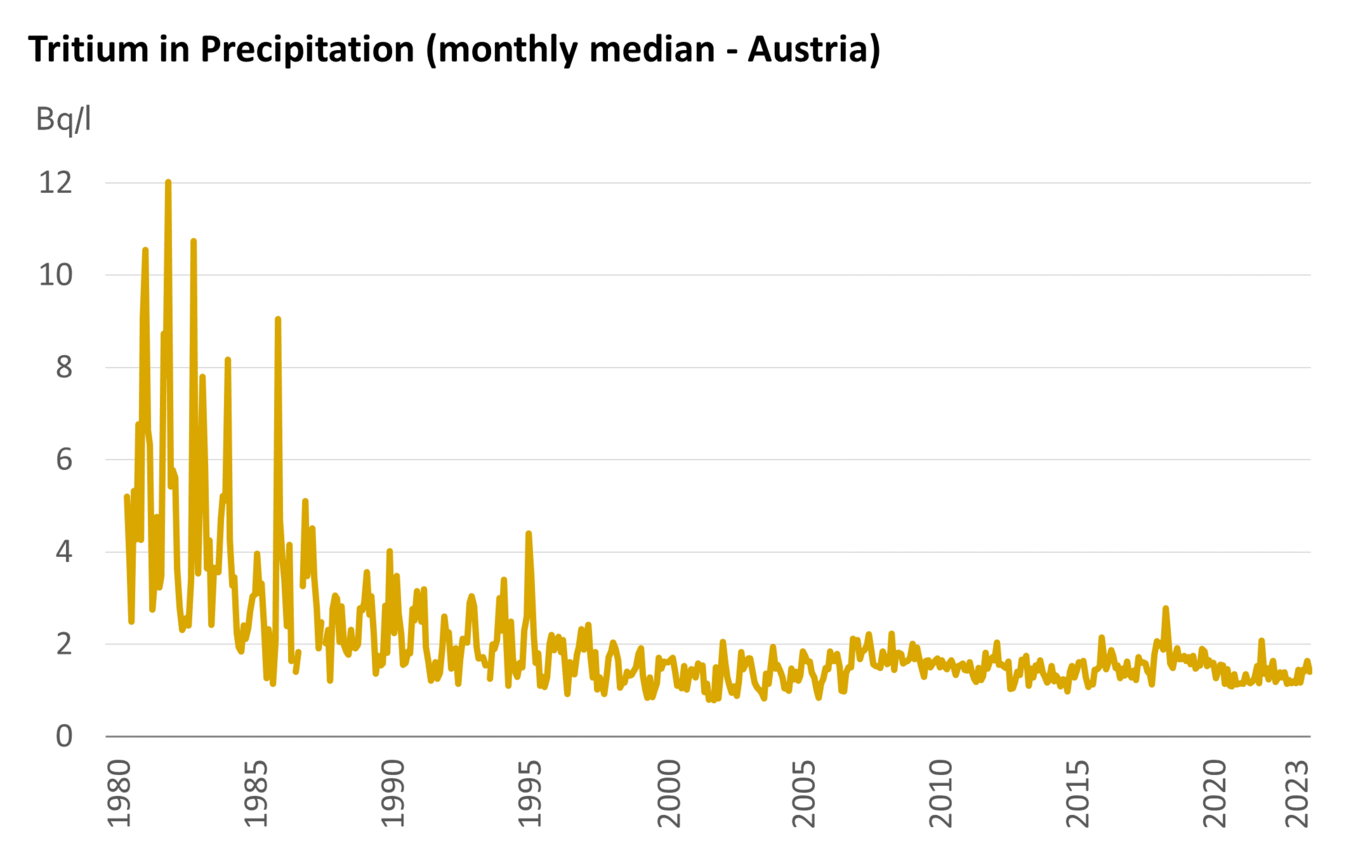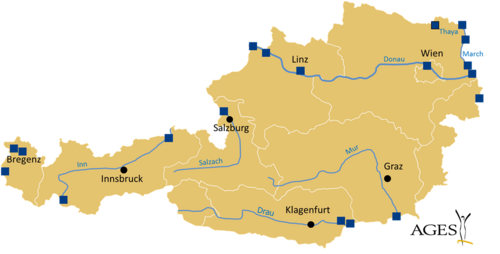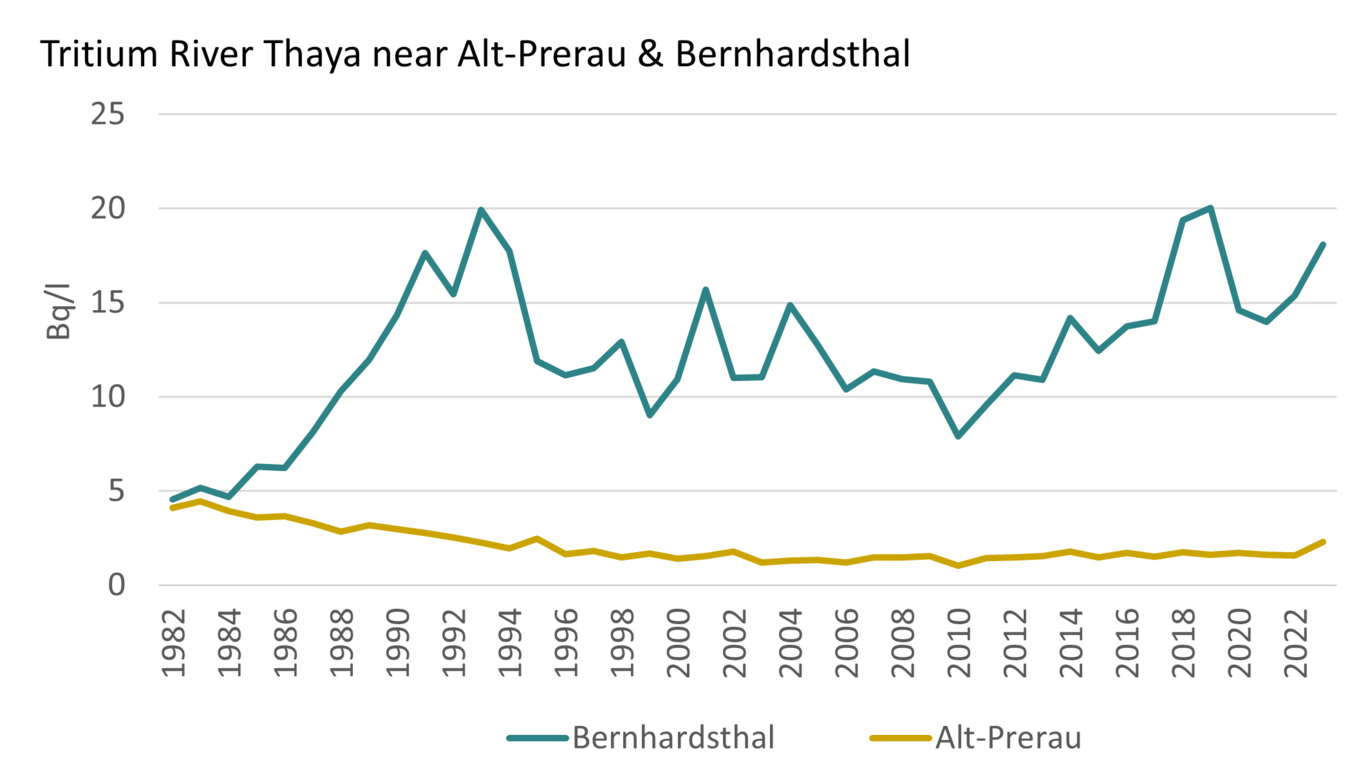Origin of radioactivity
The majority of the radioactivity measured is of natural origin and can be found everywhere in nature. Our tests are carried out in order to see whether the amount of artificial radionuclides in the environment changes. The artificial radionuclides present in nature originate from atmospheric nuclear weapons tests, the reactor accident in Chernobyl and nuclear facilities or nuclear applications.
Radioactivity in the air
Air is one of the most important ways in which radioactivity can spread in the environment. This is because air currents can transport radioactive particles over long distances. Therefore, measuring radioactivity in the air is one of the most important tasks that we carry out as part of environmental monitoring. Radioactive particles in the air are collected throughout Austria at eleven locations in Retz, Alt-Prerau, Vienna, Linz, Graz, Straß, Klagenfurt, Salzburg, Sonnblick, Innsbruck and Bregenz (see graphic).
Most radioactive substances in the air are bound to droplets or particles (aerosols). During sampling, air is sucked through a filter. The droplets and particles remain on the filter and are collected. In addition to that we operate specialised air sampling instruments that are capable of detecting gaseous radionuclides, such as radioactive iodine, at certain locations (Vienna, Linz and Innsbruck).
Air filter samples are collected over a period of one week. The filters are then replaced and sent to our radioactivity measurement laboratories. The filters are pressed into appropriate sample containers and then measured on highly sensitive detectors. Our experts analyse the measurement results and immediately report any unusual readings to the responsible federal ministries. In 2023, a total of 782 samples were collected and analysed for the purpose of monitoring Austria’s air.
Radionuclides
Nuclides are a type of atom. Radioactive nuclides are also called radionuclides. We mainly detect natural radionuclides in the air. They stem from the radioactive noble gas radon or are produced in the atmosphere by radiation from outer space (cosmogenic radionuclides).
Radionuclides - Klagenfurt: Beryllium-7
The most important cosmogenic radionuclide is beryllium-7. As an example the following figure shows the development of the beryllium-7 content in the air in Klagenfurt over the last few years. The fluctuations at different times of the year are mainly due to the weather.
Radionuclides - Klagenfurt: Caesium-137
Next to natural radionuclides, the artificial radionuclide caesium-137 is also regularly detected in the air. Caesium-137 was released during the reactor accident in Chernobyl in 1986 and can still be detected today. The following figure shows an example of the development of the caesium-137 content in the air in Klagenfurt. In addition to a steady decrease, the curve also shows seasonal fluctuations. The higher values observed during winter are due to a lower exchange rate between different air layers resulting from the weather.
Radionuclides - Klagenfurt: A comparions of beryllium-7 and caesium-137
In direct comparison, the amount of artificial radioactivity is far lower than the amount of natural radioactivity. For example, the activity of caesium-137 (artificial) is hundreds to tens of thousands of times lower than that of beryllium-7 (natural), depending on the time of year (see graph below).
In addition to these regularly occurring radionuclides, small traces of iodine-131 were once detected in an air filter from Klagenfurt in 2021 (4.5 μBq/m³, which is only slightly above the detection limit). The measured activity is irrelevant from a health perspective.
No unusual radionuclides were detected in 2022. The values of the measured radionuclides were within the normal range. We found no values that could affect human health.
Radioactivity in precipitation
Radioactive particles can be transported over long distances by air currents. Precipitation (rain, snow, etc.) can wash these particles out of the air. Thus, precipitation is considered as an important indicator for the spread of radioactivity in the environment. The measurement of radioactivity in precipitation is therefore an important task that we carry out as part of environmental monitoring. Precipitation is collected at nine locations throughout Austria (see diagram).
The precipitation is collected over a period of one month and then sent to our radioactivity measurement laboratories. Here, the precipitation samples are usually evaporated and the resulting residues are pressed into appropriate measuring containers. The measurement is carried out using highly sensitive detectors. Our experts analyse the measurement results and immediately report to the responsible federal ministries in the event of unusual measured values.
In 2023, a total of 109 samples were collected and analysed for precipitation monitoring.
Radionuclides
The radionuclides tritium, beryllium-7 and caesium-137 are typically detected in precipitation. The graph shows the development of the tritium activity concentration in precipitation over time.
The tritium present in the environment today is partly of cosmogenic and partly of artificial origin. "Cosmogenic" means that the tritium is produced in the Earth's atmosphere by particle radiation from space. The atmospheric nuclear weapons tests of the 1950s and 1960s are the main source of the artificial tritium that is present .
The caesium-137 regularly detected in precipitation largely originates from the reactor accident in Chernobyl. In 2023, 12 measured values were above the detection limit. The highest measured value was 0.15 Bq/m² (Salzburg, July 2023), the median was 0.03 Bq/m². The measured values were thus within the range of recent years.
No values that could affect human health were detected.
Radioactivity in surface water
Surface waters include rivers and lakes. In the event of reactor accidents, radioactive substances can enter surface waters via the cooling circuit. In such a case, these radioactive particles would be transported over long distances and also across borders by rivers. For this reason, river water is sampled in Austria primarily when it crosses the border into the federal territory. Sampling is also carried out where large rivers leave Austria to ensure that no radionuclides were discharged into the water within Austria.
Random samples are generally taken monthly. In addition, some rivers are sampled using automatic collection devices. These are used to take samples at regular intervals over the course of a month, which are then combined into one sample. This comes very close to continuous sampling. Surface water is sampled at 19 locations in all federal states throughout Austria (see chart). In 2023, a total of 286 surface water samples were collected and analysed.
The radionuclides tritium, beryllium-7, potassium-40 and caesium-137 are typically detected in surface water. The natural radionuclide beryllium-7 and the natural portion of tritium are continuously produced in the atmosphere (cosmogenic). Potassium-40 is a natural radionuclide with a very long half-life that already existed when the solar system was formed (primordial radionuclide).
The graph shows the development of the tritium activity concentration at two sampling points on the river Thaya. An annual average value was calculated from the monthly measurement values.
Elevated tritium concentrations have been detected at the sampling point on the Thaya in Bernhardsthal since around mid-1985. No elevated tritium levels have been recorded at the sampling point in Alt-Prerau, which is located upstream. After Alt-Prerau, the Thaya leaves Austria and flows through Czech territory as far as Bernhardsthal. In the Czech Republic it is fed by the Jihlava River, on the upper reaches of which the Dukovany nuclear power plant is located. The origin of the tritium is therefore assumed to be in the Czech Republic.
Since 1985 elevated tritium levels have also been found in the river Morava, into which the river Thaya flows. Due to the increasing dilution with water from tributaries, the tritium concentrations decrease downstream.
The activities of the radionuclides regularly found in surface waters corresponded to the long-term average. No values that could affect human health were detected.
Wastewater Treatment Plants
The wastewater and sludge from the wastewater treatment plants in Gössendorf (Graz), Feuerbach (Klagenfurt), Asten (Linz), and Simmering (Vienna) are regularly tested for radioactive substances. These samples detect not only naturally occurring radionuclides and radionuclides from the Chernobyl accident but also radionuclides used in nuclear medicine for diagnostic and therapeutic purposes. These radionuclides primarily enter the wastewater treatment plants through the excretions of patients. Regularly detected radionuclides include Gallium-67, Iodine-123, Iodine-131, Indium-111, Lutetium-177, Technetium-99m, Samarium-153, Thallium-201, and Thallium-202.
For example, Lutetium-177 is used in a treatment procedure for prostate cancer. Other radionuclides are used in scintigraphy, an imaging technique where radionuclides accumulate in specific tissues and can be visualized in images. This method, for instance, can help detect bone tumours.
The radionuclides used in medicine generally have very short half-lives, meaning they decay quickly into non-radioactive elements. As a result, there is no significant accumulation of these radionuclides in the environment.
Samples from the wastewater treatment plants are typically taken monthly as spot samples. Additionally, automated sampling devices are used at the inlet and outlet of the Linz-Asten treatment plant, allowing for near-continuous sampling.
In 2023 a total of 134 samples were collected and analysed to monitor wastewater treatment plants in Austria.
The following graph shows the annual median of the measured values above the detection limit in sewage sludge and digested sludge. The three radionuclides shown in the graph are used in nuclear medicine and showed the highest activity concentrations (Technetium-99m, Lutetium-177, and Iodine-131). Sewage sludge is a byproduct of wastewater treatment in these plants. Digested sludge refers to sludge that has been stabilised through a digestion process.
The measurement results refer to the dry mass of the samples. Over the years, the annual median of the measurement results for Technetium-99m and Iodine-131 has remained in roughly the same range. For Lutetium-177, a slight increase has been observed, indicating an increased use in cancer therapy.
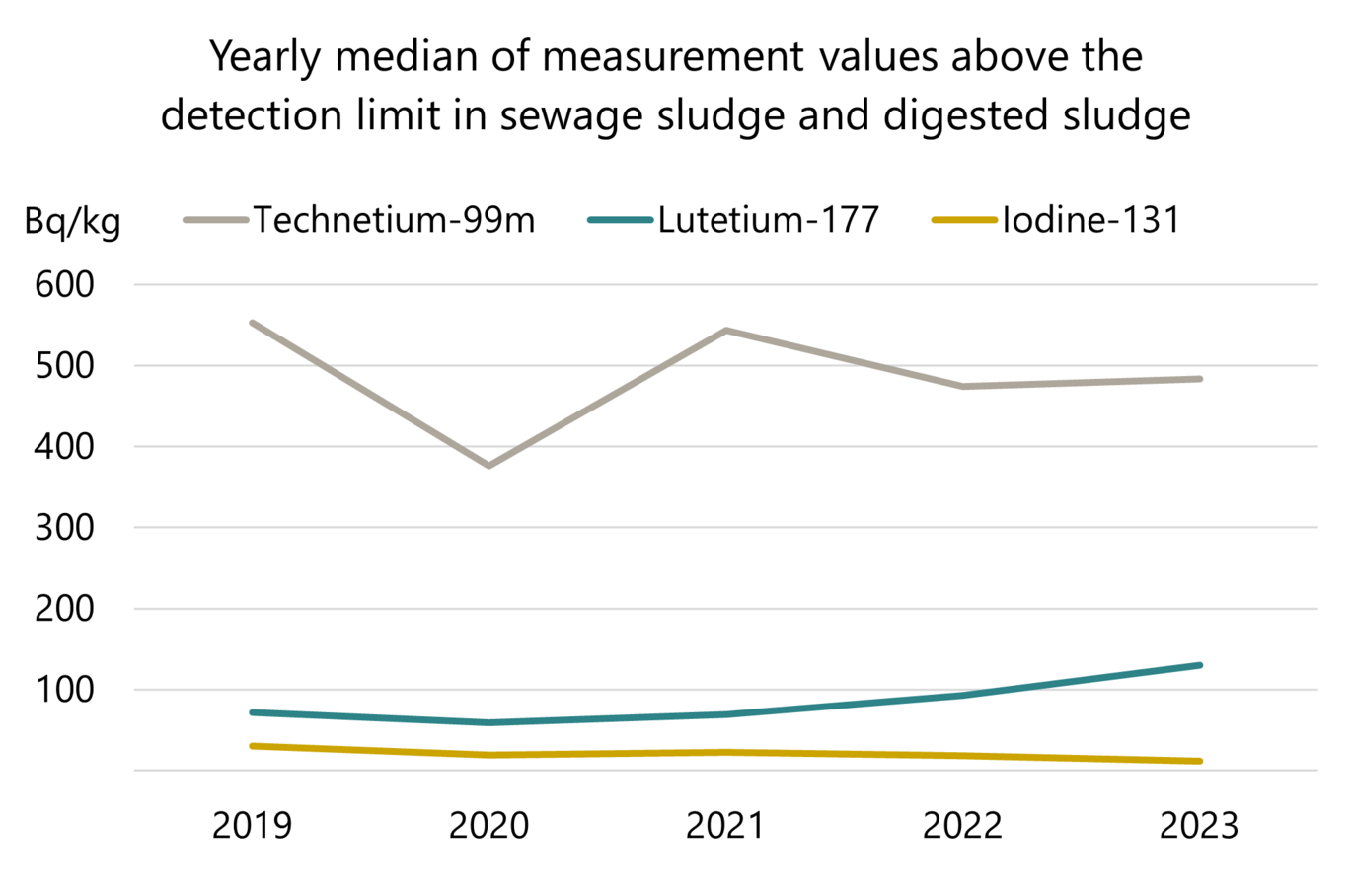
The activity concentrations of other radionuclides used in nuclear medicine typically average around 10 Bq/kg per year. Gallium-67 and Samarium-153 were not detected in any samples in 2023.
The activity concentrations found in the wastewater of treatment plants are, on average, one hundred to one thousand times lower than those in sewage and digested sludge.
The activities detected in the samples from wastewater treatment plants have no significant impact on human health.
Animal feed
Animal feed is an important part of the food chain and can have an influence on the radionuclide content in food. For this reason, they are regularly analysed by AGES as part of laboratory-based environmental monitoring.
Samples are taken at random and around 50 samples of feed from different feed categories are analysed each year. These also include feed additives like vitamins and minerals.
Monitoring and cooperation
Monitoring air, precipitation, surface water, sewage treatment plants and animal feed allows us to detect even minor increases of radioactivity in the environment and report these immediately to the responsible federal ministry. If unusual values occur, these are exchanged on a European and international level via the EU and the IAEA (International Atomic Energy Agency, International Atomic Energy Organisation) and the public is informed. In addition, radioactivity laboratories around the world are in direct contact with each other and exchange information.
Further details on environmental and food monitoring in Austria can be found in our joint report with the Ministries for Climate Protection and Health. The reports can be found under Downloads.
Radioactivity in wood fuels and their ashes
Harmful substances such as heavy metals and radioactive substances can accumulate in wood ash, although the amount can vary greatly. The accumulation of radioactive substances is highest in wood pellet ash. For this reason, among others, wood pellet ash should not be used to fertilise gardens.
Wood is a relatively fast-growing raw material and is considered an environmentally friendly, CO2-neutral fuel. The combustion process only produces ash as a waste product. For the different wood fuels (wood pellets, wood chips, logs and wood briquettes) specially designed combustion equipment is available, which is optimally adapted to the fuel used.
Heating with wood pellets is subsidised by the federal government, the federal states and the municipalities. In recent years, more and more households have been heating with pellet boilers. Nationwide, there are more pellet boilers than other biomass boilers .In Austria, only by-products from the sawmill industry and no bark are used for pellet production. During heating, the organic component of the wood is burnt, while the mineral, non-combustible part remains as ash. Plant ashes from biomass furnaces can be valuable secondary raw materials. Their possible use on agricultural and forestry land is described in more detail in the "Guideline for the proper use of plant ashes". This guideline can be found at the bottom of this page under Downloads.
Caesium and strontium in wood ash
As a result of the Chernobyl reactor accident (1986), among other things, radioactive caesium and strontium were spread across several European countries, including Austria. These radioactive substances are absorbed by the vegetation. Radioactive caesium and strontium have a half-life of around 30 years and can therefore still be found in plants (e.g. trees) and wild animals in the affected areas. . If wood from these regions is used for heating, radioactive caesium and strontium may accumulate in the ashes.
The radioactivity in the wood itself is harmless from a radiation protection point of view and therefore poses no health risk to the population. However, the amount of radioactive substances that accummulates in the wood ash may vary greatly and could be relevant from a radiation protection perspective.
AGES project: monitoring of radioactivity in wood fuels
As early as 1998, the Environment Agency Austria together with the Federal Institute for Food Analysis (now AGES) reported on the caesium content in Austrian wood ash(report). As there was little current data available for Austria, we carried out a project in 2020/21 to monitor the radioactivity content of wood fuels (in accordance with Section 125 of the Radiation Protection Act 2020). The main focus was on wood pellet samples because their ash content is the lowest compared to the ash content of other wood fuels. As a result, the accumulation of radioactive substances in wood pellet ash is higher.
Based on our project results, an estimate of the radiation exposure (= dose) when using wood pellet ash to fertilise vegetables in the garden was carried out. We assumed that a one-centimetre-thick layer of ash would be used as fertiliser each year and that half of the annually consumed vegetables would come from the garden. The highest measurement results were used for the calculation. In this case, the result is an annual dose of 0.2 millisieverts (abbreviation: mSv). As the following graph shows, this is a very low value compared to other radiation exposures.
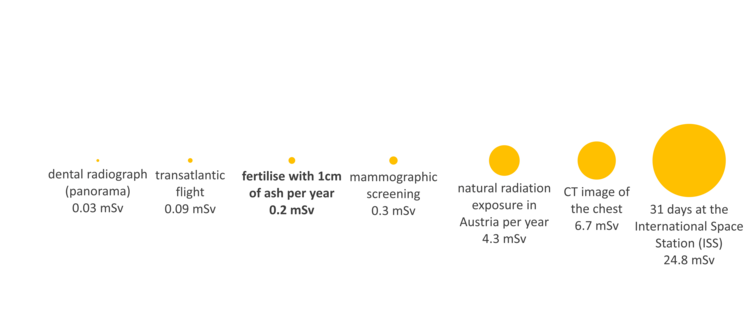
A panoramic dental X-ray corresponds to a dose of 0.03 millisieverts. A transatlantic flight or a lung X-ray corresponds to a dose of approx. 0.05 - 0.09 millisieverts, fertilising with one centimetre of ash per year corresponds to 0.2 millisieverts, a mammography examination results in approx. 0.2 to 0.3 millisieverts. The natural radiation exposure in Austria is approx. 4.3 millisieverts per year. A CT of the chest corresponds to 6.7 millisieverts and 31 days on the ISS space station results in a dose of 24.8 millisieverts.
However, we still do not recommend scattering the wood pellet ash in the garden or on a vegetable patch. This is because, in addition to radioactive substances, the ashes may also contain non-combustible and potentially harmful minerals, salts, heavy metals and organic pollutants.
The disposal of ashes from private households is regulated differently in each federal state and often also in each municipality. In most of Austria it is mandatory to dispose of the cooled ash in the residual waste.
Detailed technical information on the project can be found in the final report, which can bee downloaded here.
Contact us
Mag. Dr. Claudia Landstetter
- strahlenschutz.wien@ages.at
- +43 664 8398143
-
Spargelfeldstraße 191
1220 Wien
Last updated: 27.01.2025
automatically translated
